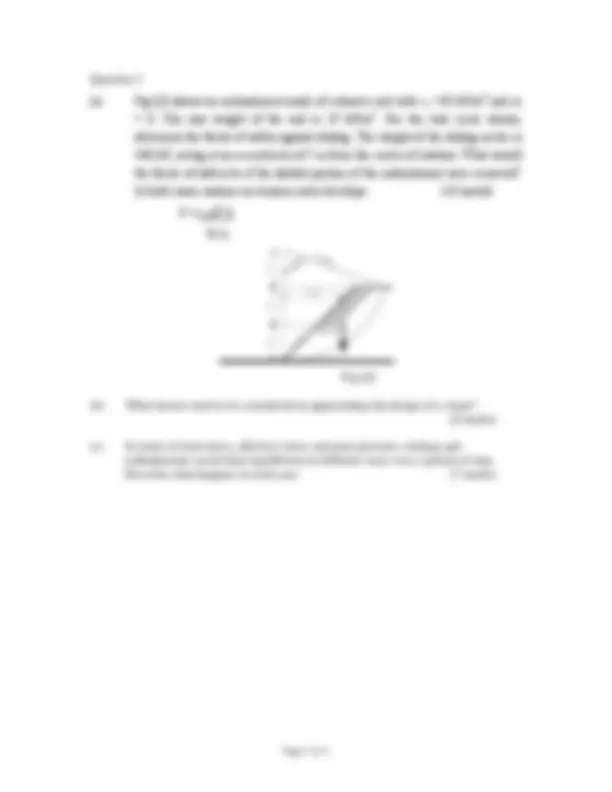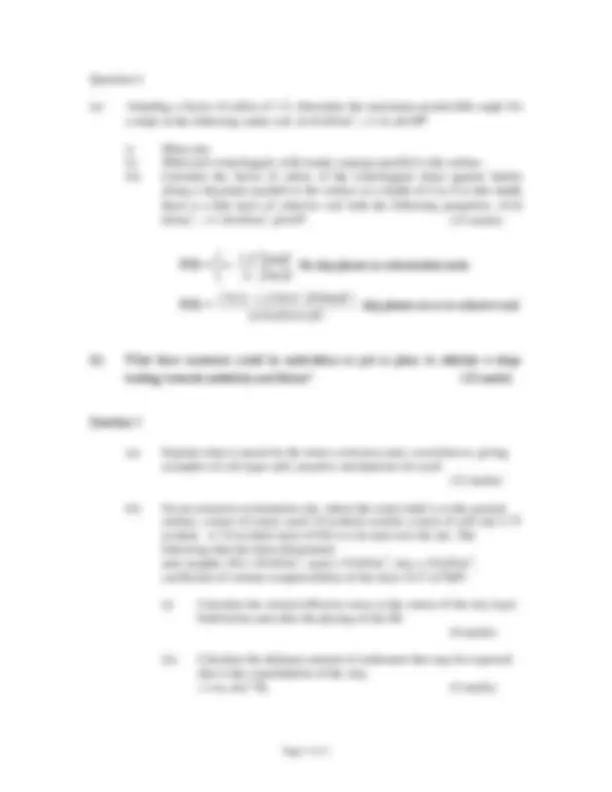




Study with the several resources on Docsity

Earn points by helping other students or get them with a premium plan


Prepare for your exams
Study with the several resources on Docsity

Earn points to download
Earn points by helping other students or get them with a premium plan
Community
Ask the community for help and clear up your study doubts
Discover the best universities in your country according to Docsity users
Free resources
Download our free guides on studying techniques, anxiety management strategies, and thesis advice from Docsity tutors
Main points of this past exam are: Types of Retaining Wall, Gravity Walls, Embedded Walls, Reinforced Earth Walls, Active Horizontal Pressure, Magnitude and Position, Resultant Active Thrust, Ultimate Bearing Capacity
Typology: Exams
1 / 4

This page cannot be seen from the preview
Don't miss anything!



Semester 1 Examinations 2012-
Module Code: CIVL
School: Building & Civil Engineering
Programme Title: B.Eng in Civil Engineering
Programme Code: CCIVE_7_Y
External Examiner(s): Mr Brian Byrne, Mr Adrian Cunningham
Internal Examiner(s): N. Hurley
Instructions: Answer FOUR questions, include units with your answers where applicable
Duration: 2 Hours
Sitting: Winter 2012
Requirements for this examination:
Note to Candidates: Please check the Programme Title and the Module Title to ensure that you are attempting the correct examination. If in doubt please contact an Invigilator.
(a) Describe the following types of retaining wall, using diagrams, explaining how stability is achieved and maintained: (i) gravity walls, (ii) embedded walls, (iii) reinforced earth walls (9 marks)
(b) Calculate the magnitude and position of the resultant active thrust on a vertical wall 10 m high retaining soil (surface horizontal, no surcharge) with the following characteristics c’ = 20 kN/m^2 , φ = 22o^ , γ = 19 kN/m^3 , γsat = 21 kN/m^3. The water table is at a depth of 6 m behind the wall. (12 marks) σ'ha = Ka σv’ – 2 c’√Ka
(c) Why can the formula for active horizontal pressure be reduced for cohesive soils? (4 marks)
Question 2
(a) Check the stability of a masonry retaining wall of height 8.0 m, crest width 1.4 m and base width 4.0 m. The back is vertical and the finished soil surface horizontal and level with the crest. Consider the stability against overturning and sliding using a factor of safety of 1.5 and calculate the bearing pressure under the base. Use c’ = 0, φ’ = 33o^ , γsoil = 20 kN/m^3 and γmasonry = 24 kN/m^3. Assume the ultimate bearing capacity of the soil under the wall is 350 kN/m^2 and the water table is well below the base of the wall. _ (20 marks) qmax = V + 6Ve x = Ms - Mo B B^2 Pa
(b) If the wall fails in sliding, what can be done to provide additional sliding resistance? (5 marks)
(a) Adopting a factor of safety of 1.5, determine the maximum permissible angle for
i) When dry ii) When just waterlogged, with steady seepage parallel to the surface iii) Calculate the factor of safety of the waterlogged slope against failure along a slip plane parallel to the surface at a depth of 4 m if at this depth
tan
tan ' (^1)
z
wh for slip planes in cohesionless soils
(sin )(cos )
' ( )(cos^2 )(tan ')
z
c z wh slip planes on or in cohesive soil
(b) What three measures could be undertaken or put in place to stabilise a slope
tending towards instability and failure? (10 marks)
Question 5
(a) Explain what is meant by the terms settlement and consolidation , giving examples of soil types and causative mechanisms for each (12 marks)
(b) On an extensive reclamation site, where the water table is at the ground surface, a layer of coarse sand 3.0 m thick overlies a layer of soft clay 5. m thick. A 3.0 m thick layer of fill is to be laid over the site. The following data has been determined: unit weights: fill = 20 kN/m^3 , sand = 19 kN/m^3 , clay = 18 kN/m^3 , coefficient of volume compressibility of the clay= 0.27 m^2 /MN
(i) Calculate the vertical effective stress at the centre of the clay layer both before and after the placing of the fill. (8 marks)
(ii) Calculate the ultimate amount of settlement that may be expected due to the consolidation of the clay. s = mv Δ σ’ Ho (5 marks)